CIS8004: Enterprise Planning and Implementation of Machine Learning
VerifiedAdded on 2022/11/14
|16
|3180
|110
Report
AI Summary
This report presents an implementation strategy for integrating machine learning (ML) into A-Z Automotive Insurance Company. It examines customer journey analysis, information architecture, technology architecture, and the agile governance methodology. The report details the work breakdown structure across initiation, planning, execution, monitoring, and closure phases. It highlights critical success factors such as setting realistic expectations, establishing common goals, defining a realistic budget, maintaining management commitment, and stakeholder participation. Furthermore, the report offers recommendations regarding management resources and project team roles, emphasizing effective communication channels. Overall, the report provides a comprehensive guide for a successful ML implementation, addressing key challenges and providing actionable insights to enhance business processes and customer relationships.
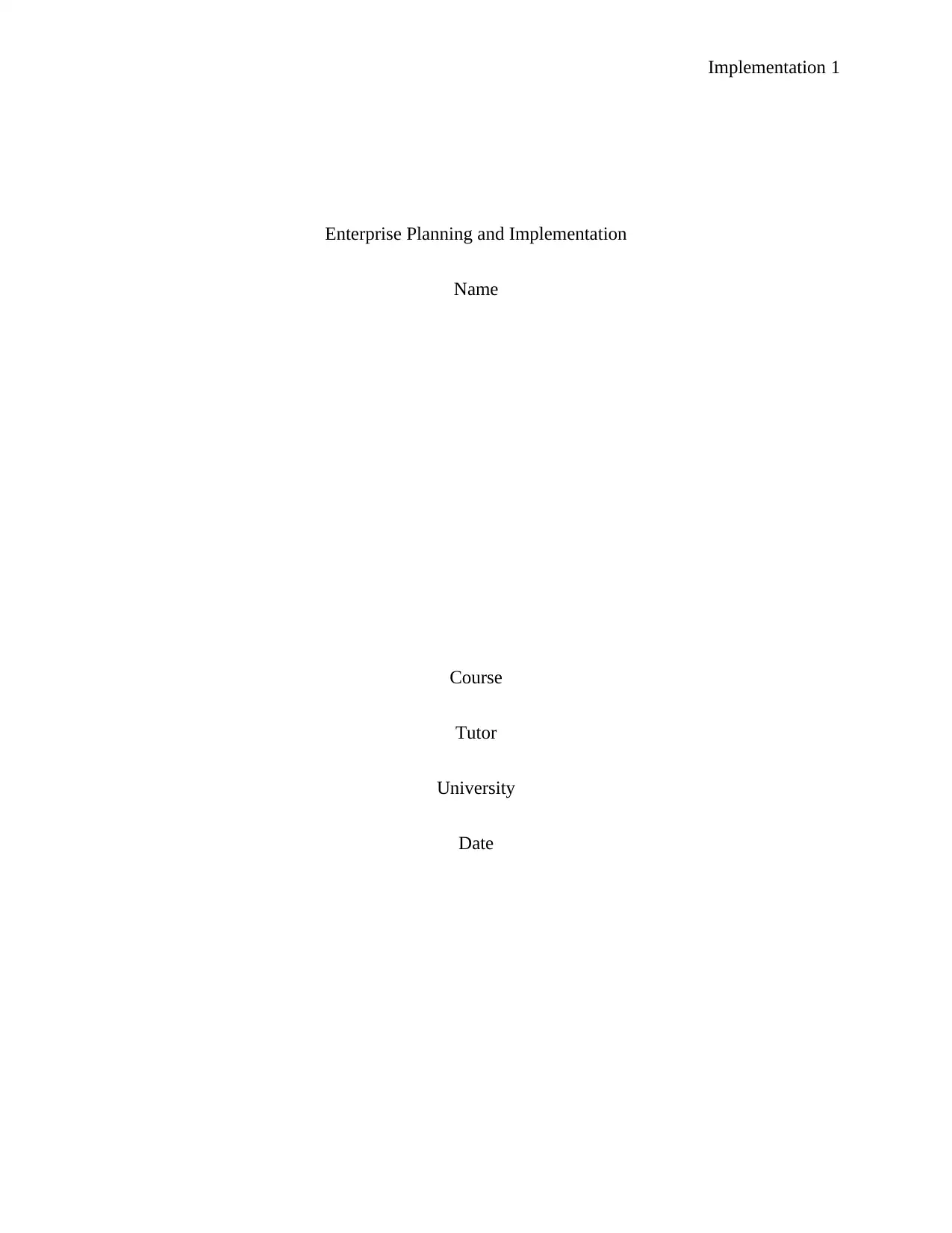
Implementation 1
Enterprise Planning and Implementation
Name
Course
Tutor
University
Date
Enterprise Planning and Implementation
Name
Course
Tutor
University
Date
Paraphrase This Document
Need a fresh take? Get an instant paraphrase of this document with our AI Paraphraser
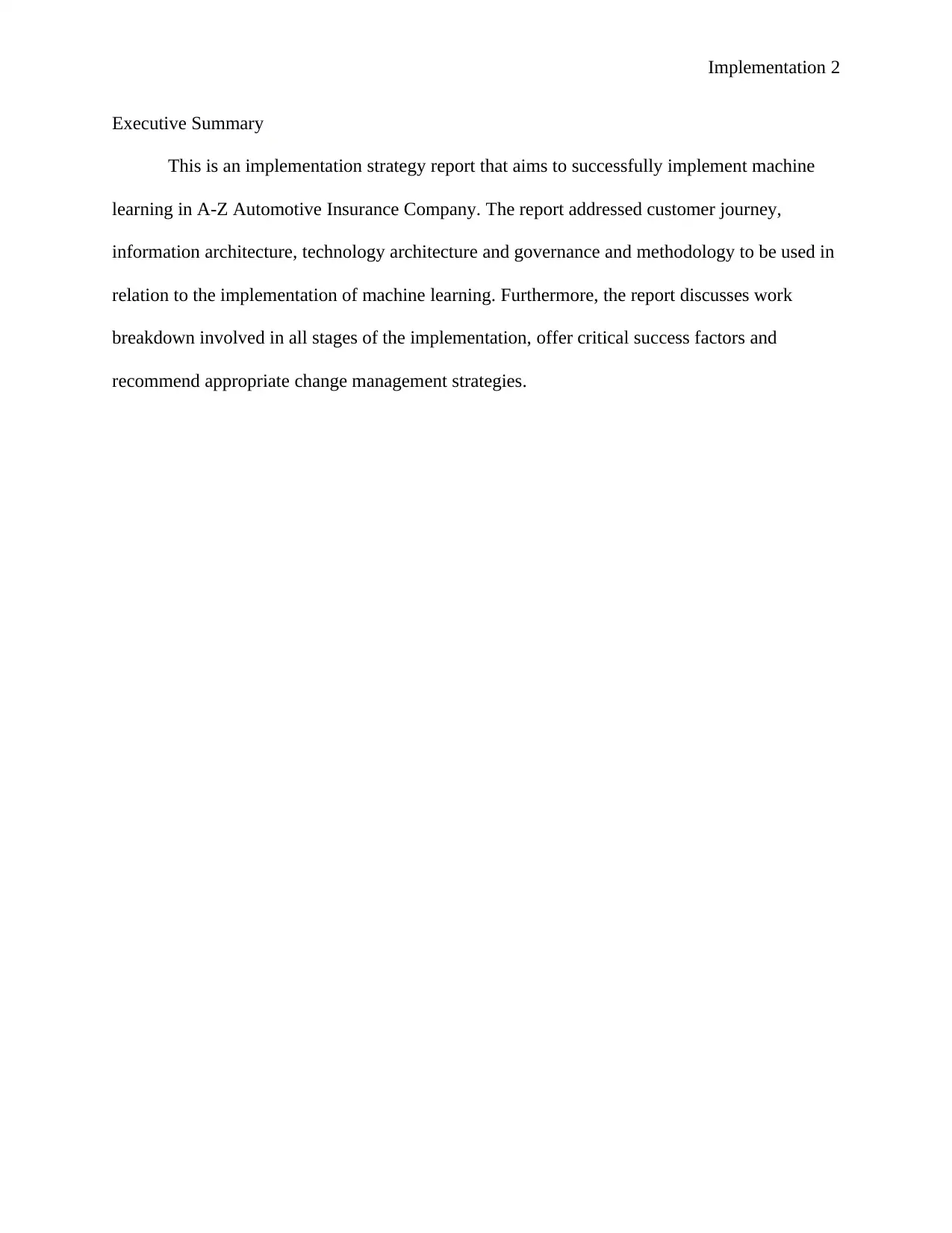
Implementation 2
Executive Summary
This is an implementation strategy report that aims to successfully implement machine
learning in A-Z Automotive Insurance Company. The report addressed customer journey,
information architecture, technology architecture and governance and methodology to be used in
relation to the implementation of machine learning. Furthermore, the report discusses work
breakdown involved in all stages of the implementation, offer critical success factors and
recommend appropriate change management strategies.
Executive Summary
This is an implementation strategy report that aims to successfully implement machine
learning in A-Z Automotive Insurance Company. The report addressed customer journey,
information architecture, technology architecture and governance and methodology to be used in
relation to the implementation of machine learning. Furthermore, the report discusses work
breakdown involved in all stages of the implementation, offer critical success factors and
recommend appropriate change management strategies.
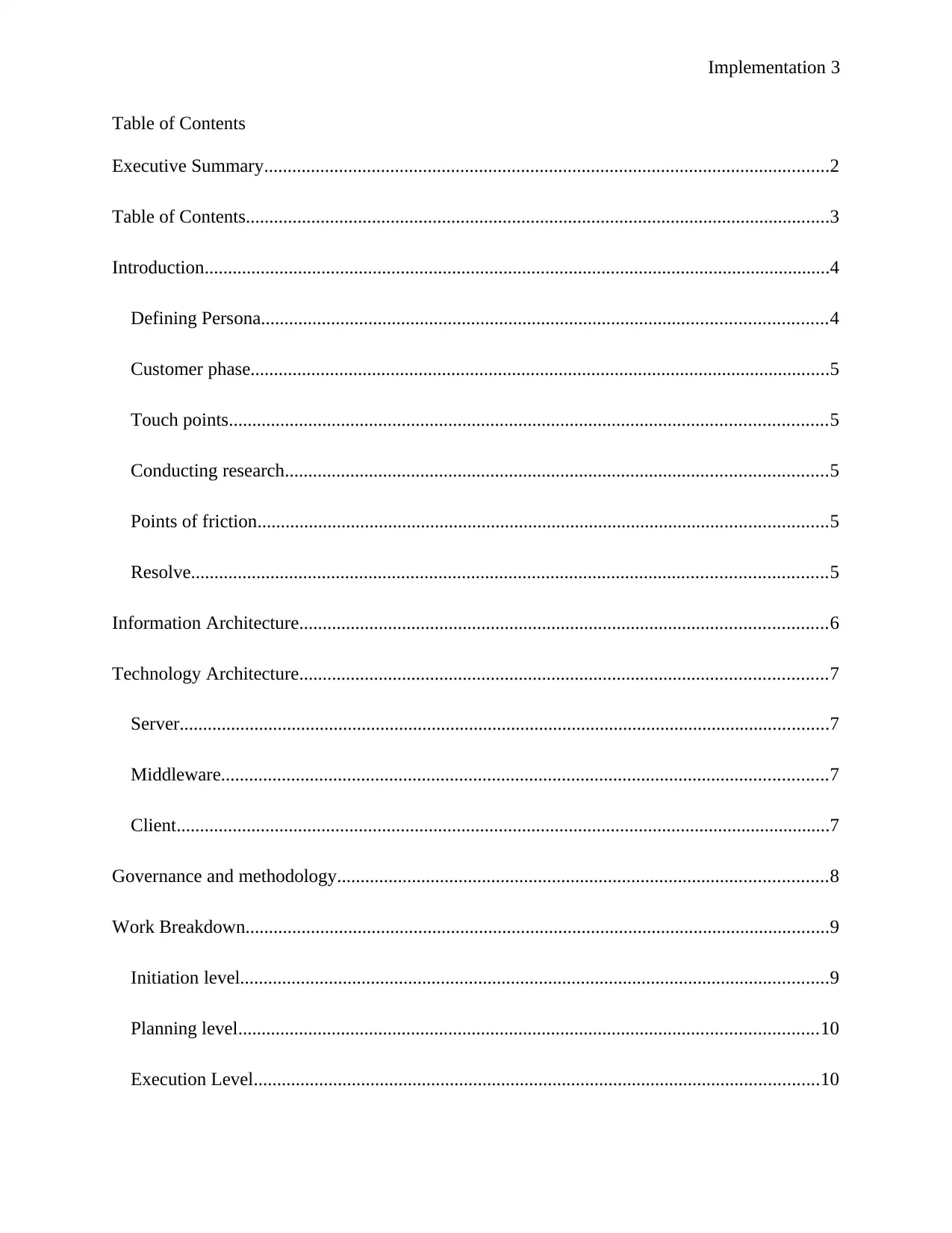
Implementation 3
Table of Contents
Executive Summary.........................................................................................................................2
Table of Contents.............................................................................................................................3
Introduction......................................................................................................................................4
Defining Persona.........................................................................................................................4
Customer phase............................................................................................................................5
Touch points................................................................................................................................5
Conducting research....................................................................................................................5
Points of friction..........................................................................................................................5
Resolve........................................................................................................................................5
Information Architecture.................................................................................................................6
Technology Architecture.................................................................................................................7
Server...........................................................................................................................................7
Middleware..................................................................................................................................7
Client............................................................................................................................................7
Governance and methodology.........................................................................................................8
Work Breakdown.............................................................................................................................9
Initiation level..............................................................................................................................9
Planning level............................................................................................................................10
Execution Level.........................................................................................................................10
Table of Contents
Executive Summary.........................................................................................................................2
Table of Contents.............................................................................................................................3
Introduction......................................................................................................................................4
Defining Persona.........................................................................................................................4
Customer phase............................................................................................................................5
Touch points................................................................................................................................5
Conducting research....................................................................................................................5
Points of friction..........................................................................................................................5
Resolve........................................................................................................................................5
Information Architecture.................................................................................................................6
Technology Architecture.................................................................................................................7
Server...........................................................................................................................................7
Middleware..................................................................................................................................7
Client............................................................................................................................................7
Governance and methodology.........................................................................................................8
Work Breakdown.............................................................................................................................9
Initiation level..............................................................................................................................9
Planning level............................................................................................................................10
Execution Level.........................................................................................................................10
⊘ This is a preview!⊘
Do you want full access?
Subscribe today to unlock all pages.

Trusted by 1+ million students worldwide
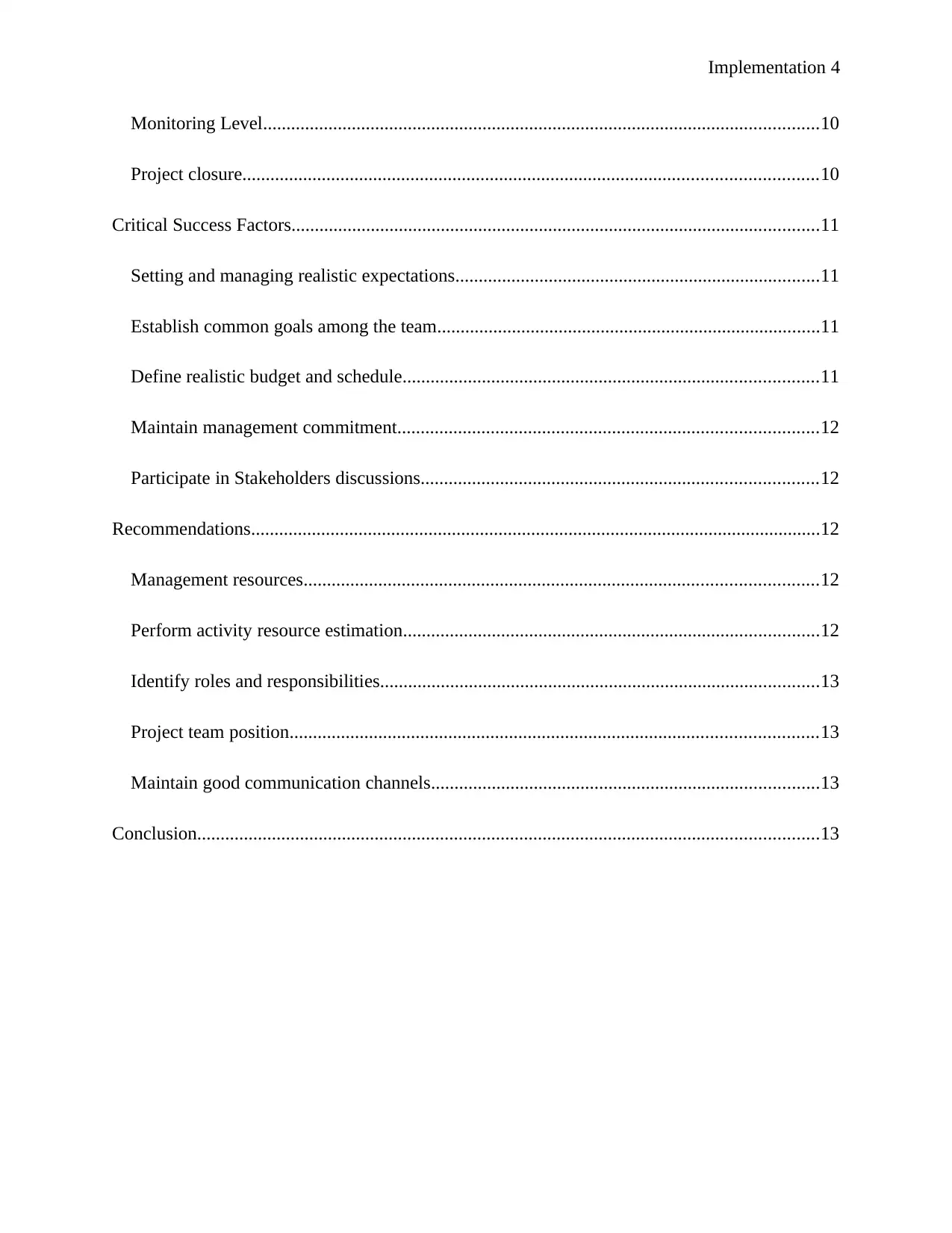
Implementation 4
Monitoring Level.......................................................................................................................10
Project closure...........................................................................................................................10
Critical Success Factors.................................................................................................................11
Setting and managing realistic expectations..............................................................................11
Establish common goals among the team..................................................................................11
Define realistic budget and schedule.........................................................................................11
Maintain management commitment..........................................................................................12
Participate in Stakeholders discussions.....................................................................................12
Recommendations..........................................................................................................................12
Management resources..............................................................................................................12
Perform activity resource estimation.........................................................................................12
Identify roles and responsibilities..............................................................................................13
Project team position.................................................................................................................13
Maintain good communication channels...................................................................................13
Conclusion.....................................................................................................................................13
Monitoring Level.......................................................................................................................10
Project closure...........................................................................................................................10
Critical Success Factors.................................................................................................................11
Setting and managing realistic expectations..............................................................................11
Establish common goals among the team..................................................................................11
Define realistic budget and schedule.........................................................................................11
Maintain management commitment..........................................................................................12
Participate in Stakeholders discussions.....................................................................................12
Recommendations..........................................................................................................................12
Management resources..............................................................................................................12
Perform activity resource estimation.........................................................................................12
Identify roles and responsibilities..............................................................................................13
Project team position.................................................................................................................13
Maintain good communication channels...................................................................................13
Conclusion.....................................................................................................................................13
Paraphrase This Document
Need a fresh take? Get an instant paraphrase of this document with our AI Paraphraser
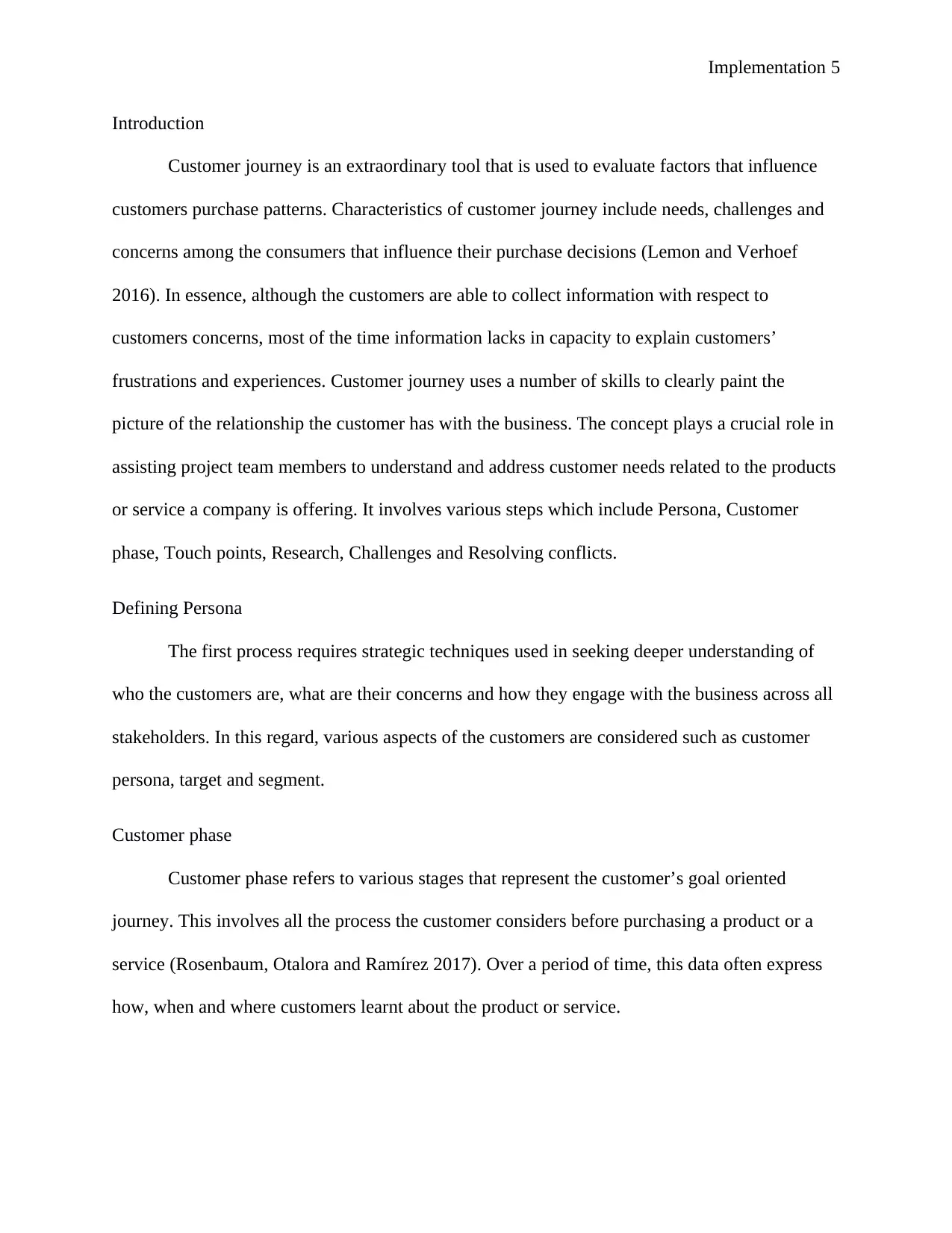
Implementation 5
Introduction
Customer journey is an extraordinary tool that is used to evaluate factors that influence
customers purchase patterns. Characteristics of customer journey include needs, challenges and
concerns among the consumers that influence their purchase decisions (Lemon and Verhoef
2016). In essence, although the customers are able to collect information with respect to
customers concerns, most of the time information lacks in capacity to explain customers’
frustrations and experiences. Customer journey uses a number of skills to clearly paint the
picture of the relationship the customer has with the business. The concept plays a crucial role in
assisting project team members to understand and address customer needs related to the products
or service a company is offering. It involves various steps which include Persona, Customer
phase, Touch points, Research, Challenges and Resolving conflicts.
Defining Persona
The first process requires strategic techniques used in seeking deeper understanding of
who the customers are, what are their concerns and how they engage with the business across all
stakeholders. In this regard, various aspects of the customers are considered such as customer
persona, target and segment.
Customer phase
Customer phase refers to various stages that represent the customer’s goal oriented
journey. This involves all the process the customer considers before purchasing a product or a
service (Rosenbaum, Otalora and Ramírez 2017). Over a period of time, this data often express
how, when and where customers learnt about the product or service.
Introduction
Customer journey is an extraordinary tool that is used to evaluate factors that influence
customers purchase patterns. Characteristics of customer journey include needs, challenges and
concerns among the consumers that influence their purchase decisions (Lemon and Verhoef
2016). In essence, although the customers are able to collect information with respect to
customers concerns, most of the time information lacks in capacity to explain customers’
frustrations and experiences. Customer journey uses a number of skills to clearly paint the
picture of the relationship the customer has with the business. The concept plays a crucial role in
assisting project team members to understand and address customer needs related to the products
or service a company is offering. It involves various steps which include Persona, Customer
phase, Touch points, Research, Challenges and Resolving conflicts.
Defining Persona
The first process requires strategic techniques used in seeking deeper understanding of
who the customers are, what are their concerns and how they engage with the business across all
stakeholders. In this regard, various aspects of the customers are considered such as customer
persona, target and segment.
Customer phase
Customer phase refers to various stages that represent the customer’s goal oriented
journey. This involves all the process the customer considers before purchasing a product or a
service (Rosenbaum, Otalora and Ramírez 2017). Over a period of time, this data often express
how, when and where customers learnt about the product or service.
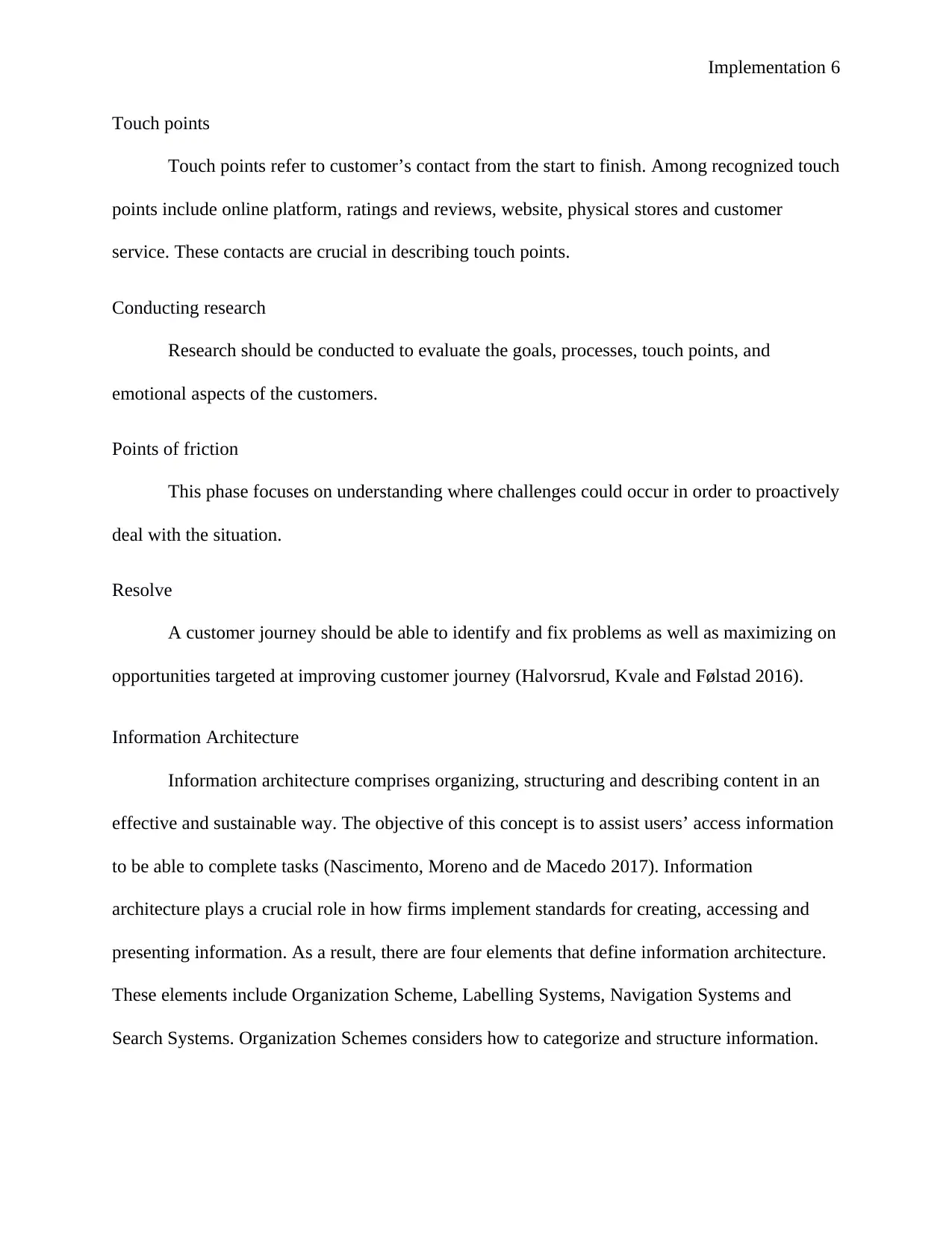
Implementation 6
Touch points
Touch points refer to customer’s contact from the start to finish. Among recognized touch
points include online platform, ratings and reviews, website, physical stores and customer
service. These contacts are crucial in describing touch points.
Conducting research
Research should be conducted to evaluate the goals, processes, touch points, and
emotional aspects of the customers.
Points of friction
This phase focuses on understanding where challenges could occur in order to proactively
deal with the situation.
Resolve
A customer journey should be able to identify and fix problems as well as maximizing on
opportunities targeted at improving customer journey (Halvorsrud, Kvale and Følstad 2016).
Information Architecture
Information architecture comprises organizing, structuring and describing content in an
effective and sustainable way. The objective of this concept is to assist users’ access information
to be able to complete tasks (Nascimento, Moreno and de Macedo 2017). Information
architecture plays a crucial role in how firms implement standards for creating, accessing and
presenting information. As a result, there are four elements that define information architecture.
These elements include Organization Scheme, Labelling Systems, Navigation Systems and
Search Systems. Organization Schemes considers how to categorize and structure information.
Touch points
Touch points refer to customer’s contact from the start to finish. Among recognized touch
points include online platform, ratings and reviews, website, physical stores and customer
service. These contacts are crucial in describing touch points.
Conducting research
Research should be conducted to evaluate the goals, processes, touch points, and
emotional aspects of the customers.
Points of friction
This phase focuses on understanding where challenges could occur in order to proactively
deal with the situation.
Resolve
A customer journey should be able to identify and fix problems as well as maximizing on
opportunities targeted at improving customer journey (Halvorsrud, Kvale and Følstad 2016).
Information Architecture
Information architecture comprises organizing, structuring and describing content in an
effective and sustainable way. The objective of this concept is to assist users’ access information
to be able to complete tasks (Nascimento, Moreno and de Macedo 2017). Information
architecture plays a crucial role in how firms implement standards for creating, accessing and
presenting information. As a result, there are four elements that define information architecture.
These elements include Organization Scheme, Labelling Systems, Navigation Systems and
Search Systems. Organization Schemes considers how to categorize and structure information.
⊘ This is a preview!⊘
Do you want full access?
Subscribe today to unlock all pages.

Trusted by 1+ million students worldwide
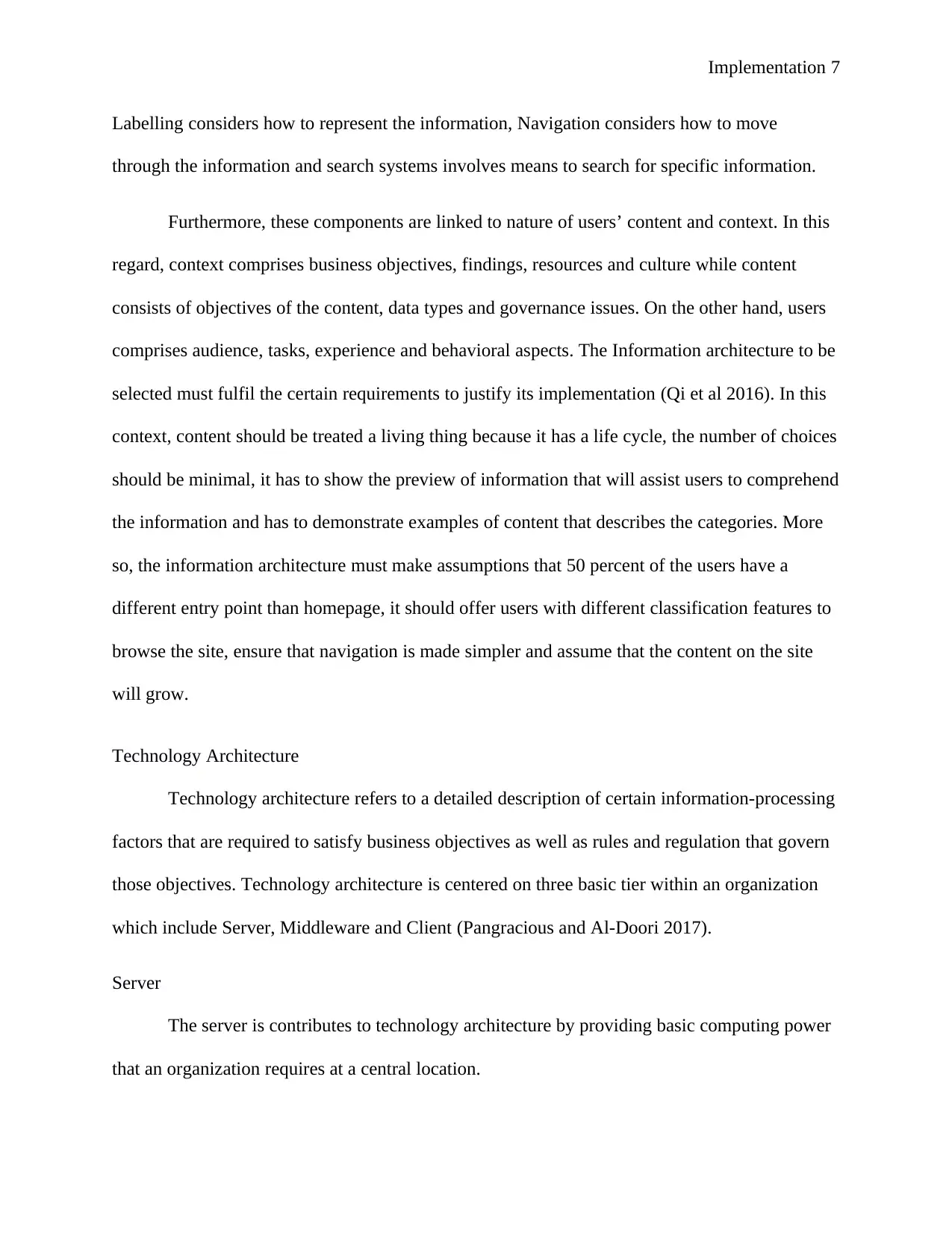
Implementation 7
Labelling considers how to represent the information, Navigation considers how to move
through the information and search systems involves means to search for specific information.
Furthermore, these components are linked to nature of users’ content and context. In this
regard, context comprises business objectives, findings, resources and culture while content
consists of objectives of the content, data types and governance issues. On the other hand, users
comprises audience, tasks, experience and behavioral aspects. The Information architecture to be
selected must fulfil the certain requirements to justify its implementation (Qi et al 2016). In this
context, content should be treated a living thing because it has a life cycle, the number of choices
should be minimal, it has to show the preview of information that will assist users to comprehend
the information and has to demonstrate examples of content that describes the categories. More
so, the information architecture must make assumptions that 50 percent of the users have a
different entry point than homepage, it should offer users with different classification features to
browse the site, ensure that navigation is made simpler and assume that the content on the site
will grow.
Technology Architecture
Technology architecture refers to a detailed description of certain information-processing
factors that are required to satisfy business objectives as well as rules and regulation that govern
those objectives. Technology architecture is centered on three basic tier within an organization
which include Server, Middleware and Client (Pangracious and Al-Doori 2017).
Server
The server is contributes to technology architecture by providing basic computing power
that an organization requires at a central location.
Labelling considers how to represent the information, Navigation considers how to move
through the information and search systems involves means to search for specific information.
Furthermore, these components are linked to nature of users’ content and context. In this
regard, context comprises business objectives, findings, resources and culture while content
consists of objectives of the content, data types and governance issues. On the other hand, users
comprises audience, tasks, experience and behavioral aspects. The Information architecture to be
selected must fulfil the certain requirements to justify its implementation (Qi et al 2016). In this
context, content should be treated a living thing because it has a life cycle, the number of choices
should be minimal, it has to show the preview of information that will assist users to comprehend
the information and has to demonstrate examples of content that describes the categories. More
so, the information architecture must make assumptions that 50 percent of the users have a
different entry point than homepage, it should offer users with different classification features to
browse the site, ensure that navigation is made simpler and assume that the content on the site
will grow.
Technology Architecture
Technology architecture refers to a detailed description of certain information-processing
factors that are required to satisfy business objectives as well as rules and regulation that govern
those objectives. Technology architecture is centered on three basic tier within an organization
which include Server, Middleware and Client (Pangracious and Al-Doori 2017).
Server
The server is contributes to technology architecture by providing basic computing power
that an organization requires at a central location.
Paraphrase This Document
Need a fresh take? Get an instant paraphrase of this document with our AI Paraphraser
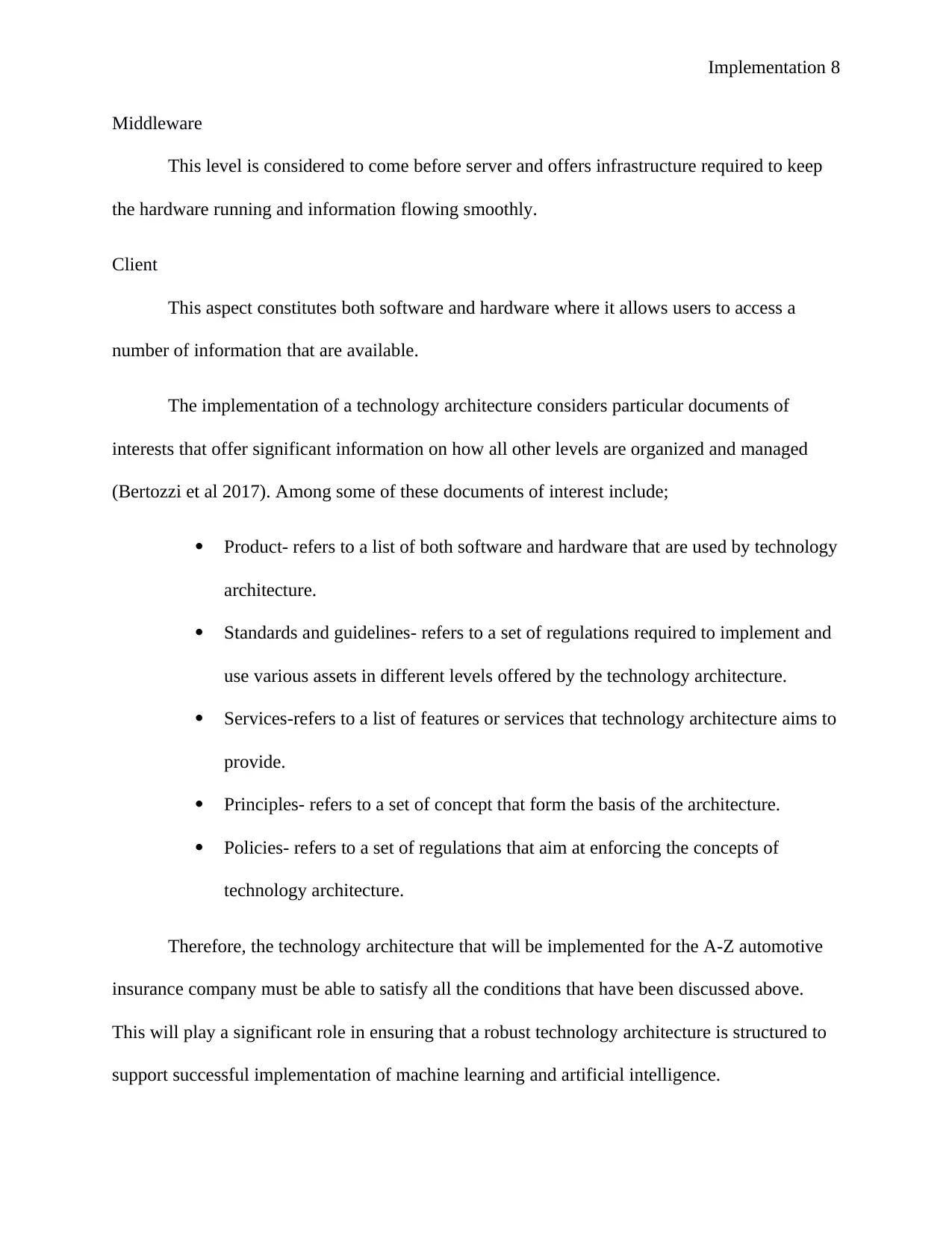
Implementation 8
Middleware
This level is considered to come before server and offers infrastructure required to keep
the hardware running and information flowing smoothly.
Client
This aspect constitutes both software and hardware where it allows users to access a
number of information that are available.
The implementation of a technology architecture considers particular documents of
interests that offer significant information on how all other levels are organized and managed
(Bertozzi et al 2017). Among some of these documents of interest include;
Product- refers to a list of both software and hardware that are used by technology
architecture.
Standards and guidelines- refers to a set of regulations required to implement and
use various assets in different levels offered by the technology architecture.
Services-refers to a list of features or services that technology architecture aims to
provide.
Principles- refers to a set of concept that form the basis of the architecture.
Policies- refers to a set of regulations that aim at enforcing the concepts of
technology architecture.
Therefore, the technology architecture that will be implemented for the A-Z automotive
insurance company must be able to satisfy all the conditions that have been discussed above.
This will play a significant role in ensuring that a robust technology architecture is structured to
support successful implementation of machine learning and artificial intelligence.
Middleware
This level is considered to come before server and offers infrastructure required to keep
the hardware running and information flowing smoothly.
Client
This aspect constitutes both software and hardware where it allows users to access a
number of information that are available.
The implementation of a technology architecture considers particular documents of
interests that offer significant information on how all other levels are organized and managed
(Bertozzi et al 2017). Among some of these documents of interest include;
Product- refers to a list of both software and hardware that are used by technology
architecture.
Standards and guidelines- refers to a set of regulations required to implement and
use various assets in different levels offered by the technology architecture.
Services-refers to a list of features or services that technology architecture aims to
provide.
Principles- refers to a set of concept that form the basis of the architecture.
Policies- refers to a set of regulations that aim at enforcing the concepts of
technology architecture.
Therefore, the technology architecture that will be implemented for the A-Z automotive
insurance company must be able to satisfy all the conditions that have been discussed above.
This will play a significant role in ensuring that a robust technology architecture is structured to
support successful implementation of machine learning and artificial intelligence.
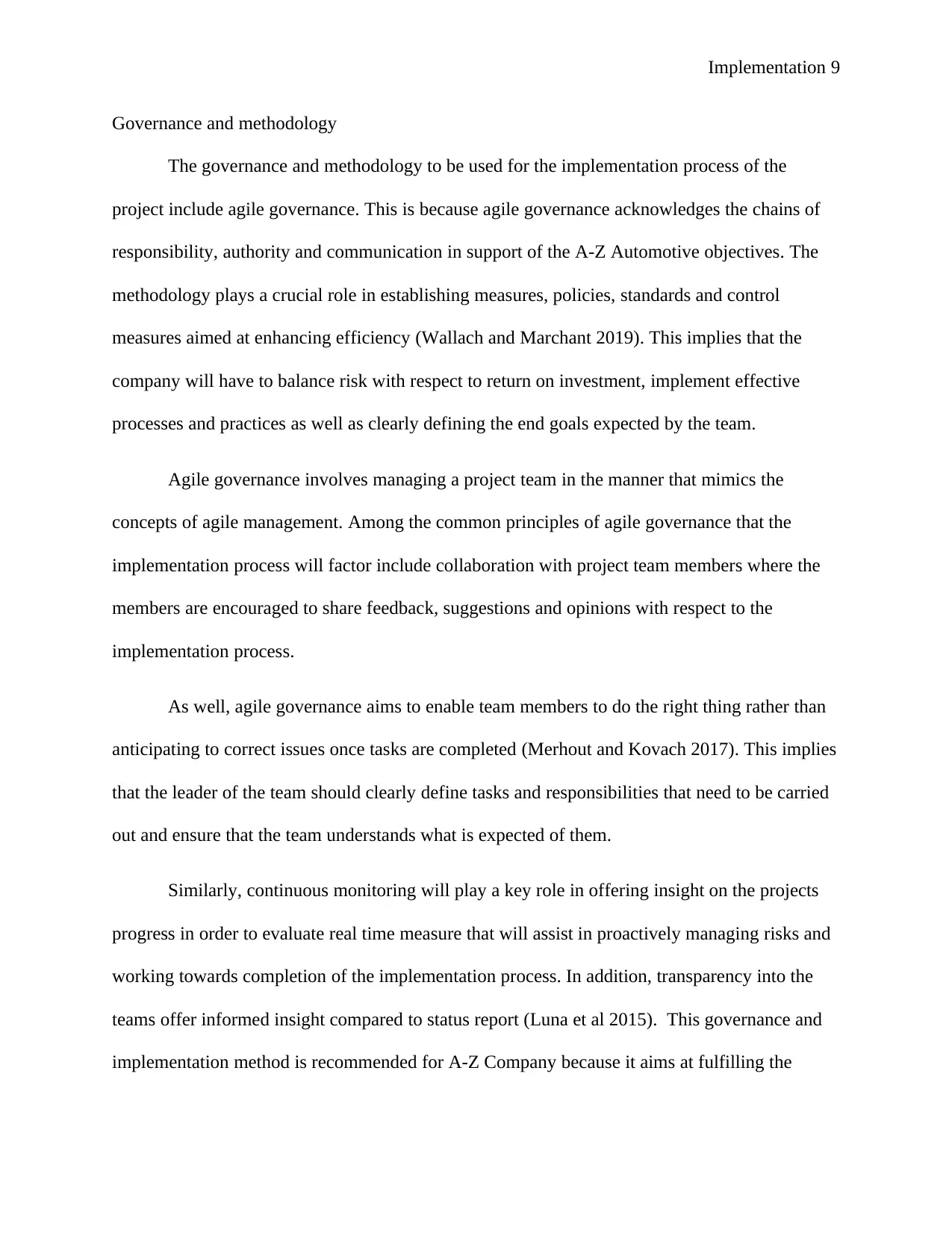
Implementation 9
Governance and methodology
The governance and methodology to be used for the implementation process of the
project include agile governance. This is because agile governance acknowledges the chains of
responsibility, authority and communication in support of the A-Z Automotive objectives. The
methodology plays a crucial role in establishing measures, policies, standards and control
measures aimed at enhancing efficiency (Wallach and Marchant 2019). This implies that the
company will have to balance risk with respect to return on investment, implement effective
processes and practices as well as clearly defining the end goals expected by the team.
Agile governance involves managing a project team in the manner that mimics the
concepts of agile management. Among the common principles of agile governance that the
implementation process will factor include collaboration with project team members where the
members are encouraged to share feedback, suggestions and opinions with respect to the
implementation process.
As well, agile governance aims to enable team members to do the right thing rather than
anticipating to correct issues once tasks are completed (Merhout and Kovach 2017). This implies
that the leader of the team should clearly define tasks and responsibilities that need to be carried
out and ensure that the team understands what is expected of them.
Similarly, continuous monitoring will play a key role in offering insight on the projects
progress in order to evaluate real time measure that will assist in proactively managing risks and
working towards completion of the implementation process. In addition, transparency into the
teams offer informed insight compared to status report (Luna et al 2015). This governance and
implementation method is recommended for A-Z Company because it aims at fulfilling the
Governance and methodology
The governance and methodology to be used for the implementation process of the
project include agile governance. This is because agile governance acknowledges the chains of
responsibility, authority and communication in support of the A-Z Automotive objectives. The
methodology plays a crucial role in establishing measures, policies, standards and control
measures aimed at enhancing efficiency (Wallach and Marchant 2019). This implies that the
company will have to balance risk with respect to return on investment, implement effective
processes and practices as well as clearly defining the end goals expected by the team.
Agile governance involves managing a project team in the manner that mimics the
concepts of agile management. Among the common principles of agile governance that the
implementation process will factor include collaboration with project team members where the
members are encouraged to share feedback, suggestions and opinions with respect to the
implementation process.
As well, agile governance aims to enable team members to do the right thing rather than
anticipating to correct issues once tasks are completed (Merhout and Kovach 2017). This implies
that the leader of the team should clearly define tasks and responsibilities that need to be carried
out and ensure that the team understands what is expected of them.
Similarly, continuous monitoring will play a key role in offering insight on the projects
progress in order to evaluate real time measure that will assist in proactively managing risks and
working towards completion of the implementation process. In addition, transparency into the
teams offer informed insight compared to status report (Luna et al 2015). This governance and
implementation method is recommended for A-Z Company because it aims at fulfilling the
⊘ This is a preview!⊘
Do you want full access?
Subscribe today to unlock all pages.

Trusted by 1+ million students worldwide
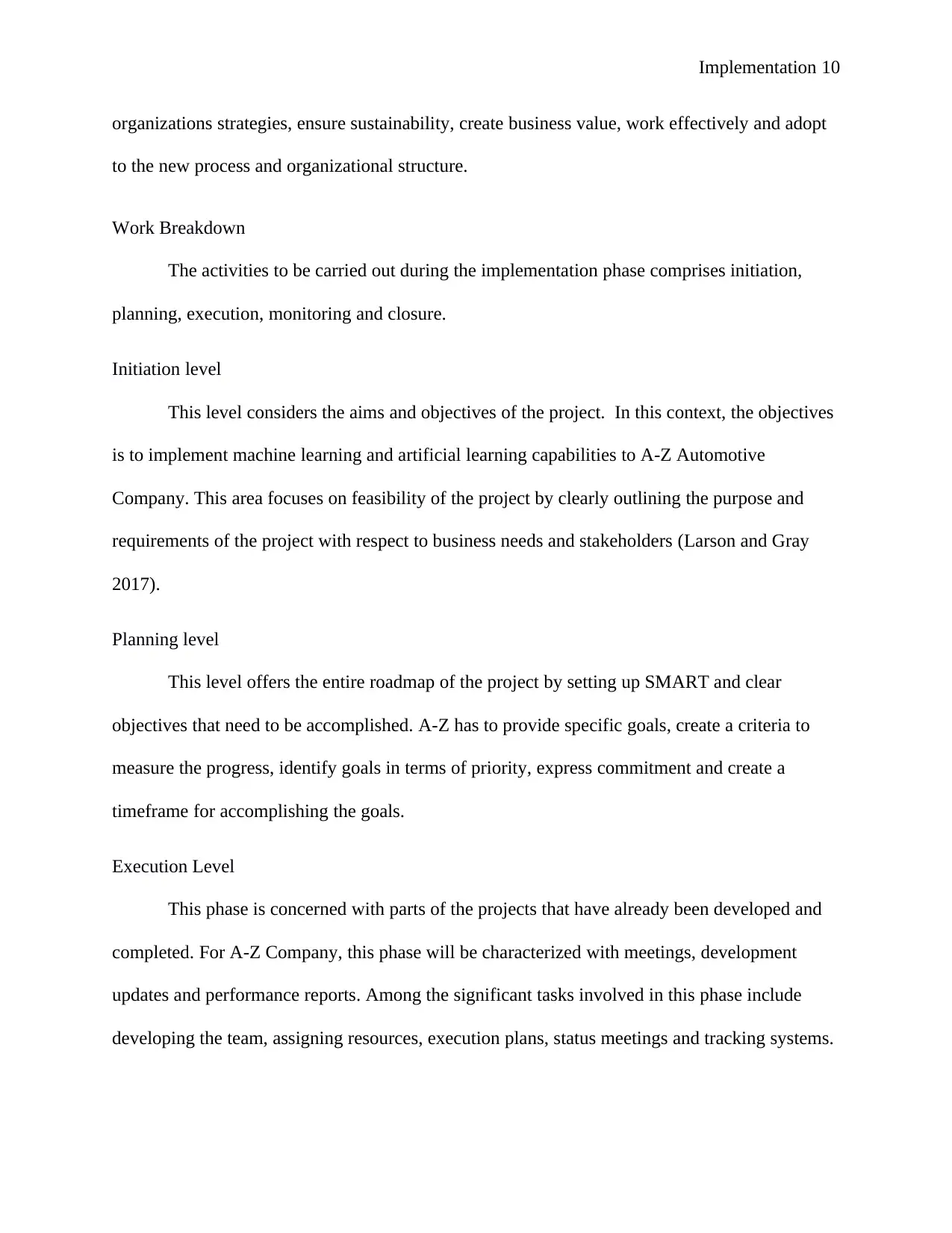
Implementation 10
organizations strategies, ensure sustainability, create business value, work effectively and adopt
to the new process and organizational structure.
Work Breakdown
The activities to be carried out during the implementation phase comprises initiation,
planning, execution, monitoring and closure.
Initiation level
This level considers the aims and objectives of the project. In this context, the objectives
is to implement machine learning and artificial learning capabilities to A-Z Automotive
Company. This area focuses on feasibility of the project by clearly outlining the purpose and
requirements of the project with respect to business needs and stakeholders (Larson and Gray
2017).
Planning level
This level offers the entire roadmap of the project by setting up SMART and clear
objectives that need to be accomplished. A-Z has to provide specific goals, create a criteria to
measure the progress, identify goals in terms of priority, express commitment and create a
timeframe for accomplishing the goals.
Execution Level
This phase is concerned with parts of the projects that have already been developed and
completed. For A-Z Company, this phase will be characterized with meetings, development
updates and performance reports. Among the significant tasks involved in this phase include
developing the team, assigning resources, execution plans, status meetings and tracking systems.
organizations strategies, ensure sustainability, create business value, work effectively and adopt
to the new process and organizational structure.
Work Breakdown
The activities to be carried out during the implementation phase comprises initiation,
planning, execution, monitoring and closure.
Initiation level
This level considers the aims and objectives of the project. In this context, the objectives
is to implement machine learning and artificial learning capabilities to A-Z Automotive
Company. This area focuses on feasibility of the project by clearly outlining the purpose and
requirements of the project with respect to business needs and stakeholders (Larson and Gray
2017).
Planning level
This level offers the entire roadmap of the project by setting up SMART and clear
objectives that need to be accomplished. A-Z has to provide specific goals, create a criteria to
measure the progress, identify goals in terms of priority, express commitment and create a
timeframe for accomplishing the goals.
Execution Level
This phase is concerned with parts of the projects that have already been developed and
completed. For A-Z Company, this phase will be characterized with meetings, development
updates and performance reports. Among the significant tasks involved in this phase include
developing the team, assigning resources, execution plans, status meetings and tracking systems.
Paraphrase This Document
Need a fresh take? Get an instant paraphrase of this document with our AI Paraphraser
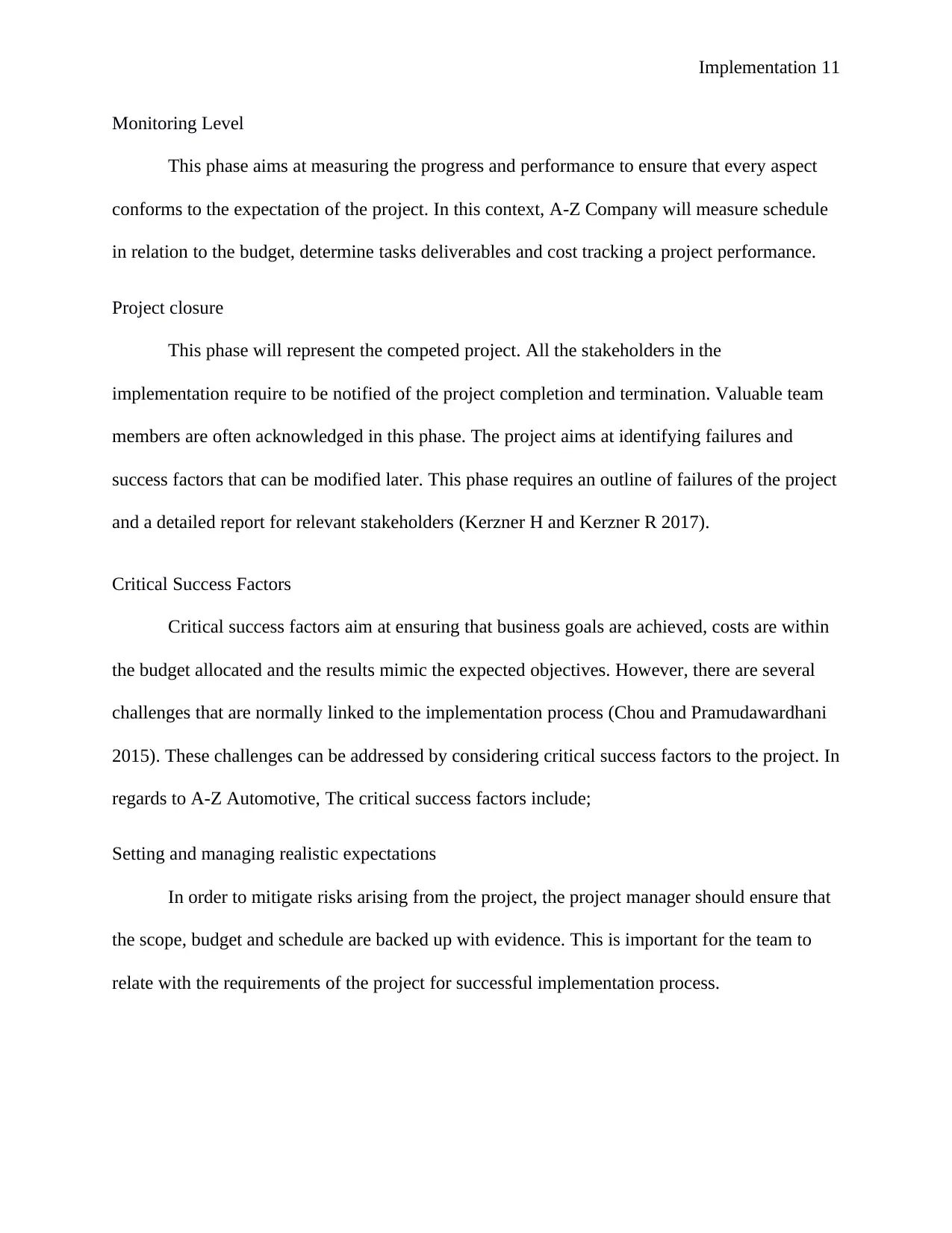
Implementation 11
Monitoring Level
This phase aims at measuring the progress and performance to ensure that every aspect
conforms to the expectation of the project. In this context, A-Z Company will measure schedule
in relation to the budget, determine tasks deliverables and cost tracking a project performance.
Project closure
This phase will represent the competed project. All the stakeholders in the
implementation require to be notified of the project completion and termination. Valuable team
members are often acknowledged in this phase. The project aims at identifying failures and
success factors that can be modified later. This phase requires an outline of failures of the project
and a detailed report for relevant stakeholders (Kerzner H and Kerzner R 2017).
Critical Success Factors
Critical success factors aim at ensuring that business goals are achieved, costs are within
the budget allocated and the results mimic the expected objectives. However, there are several
challenges that are normally linked to the implementation process (Chou and Pramudawardhani
2015). These challenges can be addressed by considering critical success factors to the project. In
regards to A-Z Automotive, The critical success factors include;
Setting and managing realistic expectations
In order to mitigate risks arising from the project, the project manager should ensure that
the scope, budget and schedule are backed up with evidence. This is important for the team to
relate with the requirements of the project for successful implementation process.
Monitoring Level
This phase aims at measuring the progress and performance to ensure that every aspect
conforms to the expectation of the project. In this context, A-Z Company will measure schedule
in relation to the budget, determine tasks deliverables and cost tracking a project performance.
Project closure
This phase will represent the competed project. All the stakeholders in the
implementation require to be notified of the project completion and termination. Valuable team
members are often acknowledged in this phase. The project aims at identifying failures and
success factors that can be modified later. This phase requires an outline of failures of the project
and a detailed report for relevant stakeholders (Kerzner H and Kerzner R 2017).
Critical Success Factors
Critical success factors aim at ensuring that business goals are achieved, costs are within
the budget allocated and the results mimic the expected objectives. However, there are several
challenges that are normally linked to the implementation process (Chou and Pramudawardhani
2015). These challenges can be addressed by considering critical success factors to the project. In
regards to A-Z Automotive, The critical success factors include;
Setting and managing realistic expectations
In order to mitigate risks arising from the project, the project manager should ensure that
the scope, budget and schedule are backed up with evidence. This is important for the team to
relate with the requirements of the project for successful implementation process.
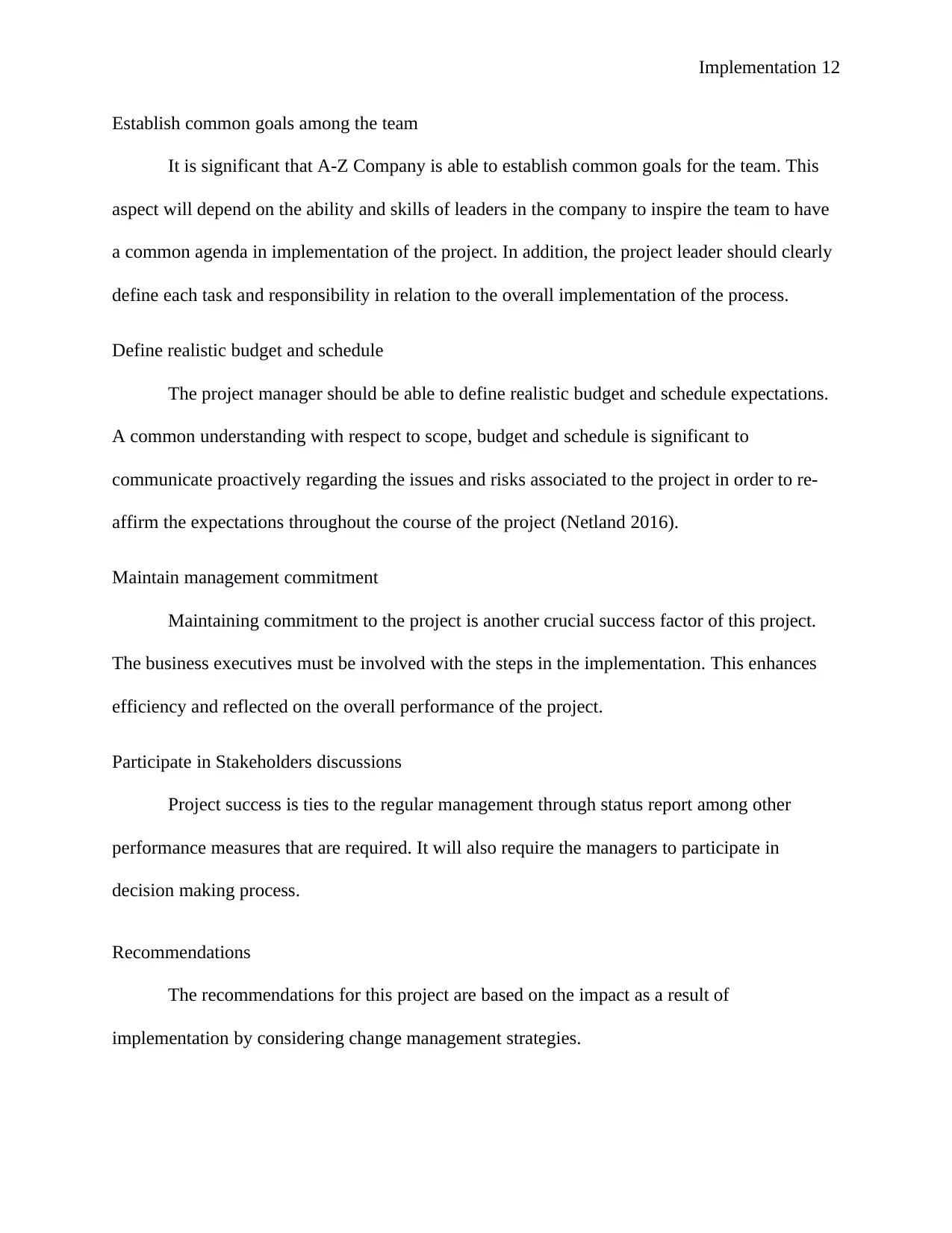
Implementation 12
Establish common goals among the team
It is significant that A-Z Company is able to establish common goals for the team. This
aspect will depend on the ability and skills of leaders in the company to inspire the team to have
a common agenda in implementation of the project. In addition, the project leader should clearly
define each task and responsibility in relation to the overall implementation of the process.
Define realistic budget and schedule
The project manager should be able to define realistic budget and schedule expectations.
A common understanding with respect to scope, budget and schedule is significant to
communicate proactively regarding the issues and risks associated to the project in order to re-
affirm the expectations throughout the course of the project (Netland 2016).
Maintain management commitment
Maintaining commitment to the project is another crucial success factor of this project.
The business executives must be involved with the steps in the implementation. This enhances
efficiency and reflected on the overall performance of the project.
Participate in Stakeholders discussions
Project success is ties to the regular management through status report among other
performance measures that are required. It will also require the managers to participate in
decision making process.
Recommendations
The recommendations for this project are based on the impact as a result of
implementation by considering change management strategies.
Establish common goals among the team
It is significant that A-Z Company is able to establish common goals for the team. This
aspect will depend on the ability and skills of leaders in the company to inspire the team to have
a common agenda in implementation of the project. In addition, the project leader should clearly
define each task and responsibility in relation to the overall implementation of the process.
Define realistic budget and schedule
The project manager should be able to define realistic budget and schedule expectations.
A common understanding with respect to scope, budget and schedule is significant to
communicate proactively regarding the issues and risks associated to the project in order to re-
affirm the expectations throughout the course of the project (Netland 2016).
Maintain management commitment
Maintaining commitment to the project is another crucial success factor of this project.
The business executives must be involved with the steps in the implementation. This enhances
efficiency and reflected on the overall performance of the project.
Participate in Stakeholders discussions
Project success is ties to the regular management through status report among other
performance measures that are required. It will also require the managers to participate in
decision making process.
Recommendations
The recommendations for this project are based on the impact as a result of
implementation by considering change management strategies.
⊘ This is a preview!⊘
Do you want full access?
Subscribe today to unlock all pages.

Trusted by 1+ million students worldwide
1 out of 16
Related Documents
Your All-in-One AI-Powered Toolkit for Academic Success.
+13062052269
info@desklib.com
Available 24*7 on WhatsApp / Email
![[object Object]](/_next/static/media/star-bottom.7253800d.svg)
Unlock your academic potential
Copyright © 2020–2025 A2Z Services. All Rights Reserved. Developed and managed by ZUCOL.



